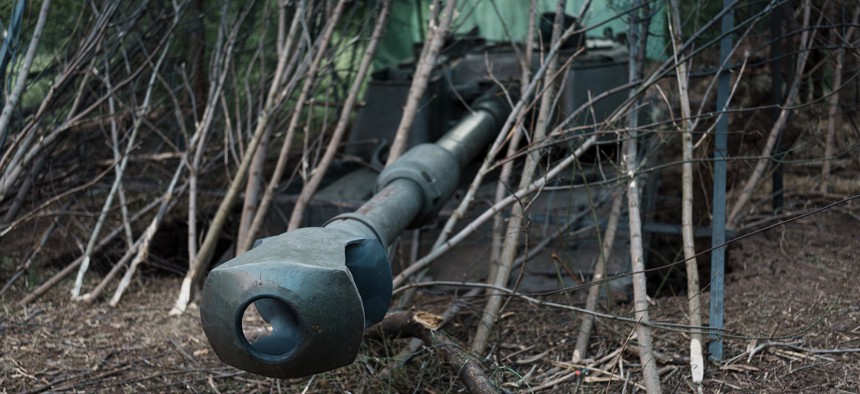
A M109A6 Paladin 155mm self-propelled howitzer stands camouflaged on a Ukrainian position on May 18, 2023 in Donetsk Oblast, Ukraine. Serhii Mykhalchuk / Global Images Ukraine via Getty Images
New 155mm round exceeds range of some rockets, can be fired by standard Army artillery
“We have now exceeded any range ever acquired” by the Paladin howitzer, BAE says.
BAE successfully tested a new hyper-long range artillery round in one of the Army’s most common howitzers, the company said Monday.
BAE first announced the new round, the XM1155-SC, in March. That test saw the precision-guided round hit a target over 68 miles away, three times farther than an average 155mm shell and farther than the range of some Army rockets.
However, the March test round was fired from an U.S. Army Extended Range Cannon Artillery cannon, or ERCA, a prototype system with an extra-long 58-caliber barrel. By contrast, the testing announced this week was fired from the Paladin’s shorter, 39-caliber barrel. The Army and allied nations widely field the Paladin, unlike the ERCA.
BAE said the round went “the furthest distance an M109 Paladin has ever fired a guided projectile,” but did not provide a specific range.
“Our intent with that round now is to prove that we can double the range of traditional artillery, regardless of the caliber of the gun,” Jim Miller, vice president of business development for combat mission systems at BAE Systems, said at a media briefing. “We now have exceeded any range ever acquired out of a [Paladin].”
The M109A7 Paladin is capable of firing long-range Excalibur projectiles at a distance of 25 to 30 miles, which suggests the new round may be capable of hitting targets at a range of up to 60 miles. The Army’s Guided Multiple Launch Rocket System (GMLRS), by contrast, has a range of 43.5 miles.
The round is able to fly further thanks to its sabot-style construction. Sabot rounds have the same rear diameter of a standard shell, to capture the explosive energy of the round’s propellant, but taper in the front to a thinner warhead.
Once fired, the round deploys fins to guide it to its target. It also contains electronic warfare defenses, a key consideration given extensive use of Russian jammers in Ukraine that targeted U.S.-supplied precision-guided rockets.
Miller did not specify a price for the round. The Army’s Excalibur round, one of the Army’s most expensive guided 155mm shells, costs as much as $100,000.
The Army is in the final stages of preparing strategy documents on the use of artillery soon, Miller said, while deferring questions about how widespread use of the round might be.
“What's going to matter is how the Army decides how precise they want to be and how far,” Miller said. “We're waiting to see what the Army says,”
Ukraine has used both the Excalibur round and the GMLRS successfully in Ukraine, particularly for targeting Russian command posts and logistics nodes. Its targeting of logistics nodes, in part, was credited with reducing Russian artillery fire by forcing Russia to push its depots farther from the front.




